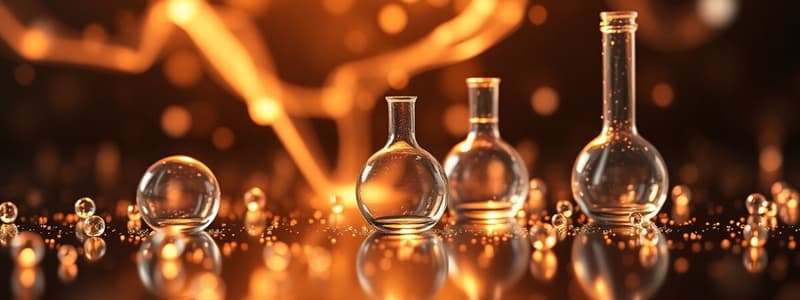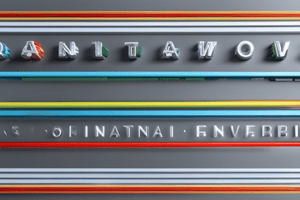Podcast
Questions and Answers
Which statement about gases is false?
Which statement about gases is false?
- Distances between molecules of gas are very large compared to bond distances within molecules.
- Gases are highly compressible.
- All gases are colorless and odorless at room temperature. (correct)
- Non-reacting gas mixtures are homogeneous.
What volume of CO2 gas at 645 torr and 800 K could be produced by the reaction of 45 g of CaCO3?
What volume of CO2 gas at 645 torr and 800 K could be produced by the reaction of 45 g of CaCO3?
- 34.8 L (correct)
- 25.0 L
- 0.449 L
- 45.7 mL
Which of the following quantum numbers corresponds to the size and energy of an orbital?
Which of the following quantum numbers corresponds to the size and energy of an orbital?
- Angular momentum quantum number
- Principal quantum number (correct)
- Magnetic quantum number
- Spin quantum number
When filling degenerate orbitals, which principle states that electrons fill them singly first with parallel spins?
When filling degenerate orbitals, which principle states that electrons fill them singly first with parallel spins?
The reaction of 6.00 kg of sodium bicarbonate with excess hydrochloric acid will produce what volume of CO2?
The reaction of 6.00 kg of sodium bicarbonate with excess hydrochloric acid will produce what volume of CO2?
What is the pressure of a 6.022 g sample of CH4 gas in a 30.0 L vessel at 402 K?
What is the pressure of a 6.022 g sample of CH4 gas in a 30.0 L vessel at 402 K?
If a gas occupies 24.5 L at a pressure of 1.57 atm, what will be the pressure if the volume is increased to 48.3 L?
If a gas occupies 24.5 L at a pressure of 1.57 atm, what will be the pressure if the volume is increased to 48.3 L?
How many moles of gas will occupy 85.5 mL if 2.3 mol of gas occupy 50.5 mL at the same temperature and pressure?
How many moles of gas will occupy 85.5 mL if 2.3 mol of gas occupy 50.5 mL at the same temperature and pressure?
What is the density of carbon dioxide, CO2(g), at 100°C and 17.0 atm pressure?
What is the density of carbon dioxide, CO2(g), at 100°C and 17.0 atm pressure?
Which of the following is a correct set of quantum numbers for an electron in a 3d orbital?
Which of the following is a correct set of quantum numbers for an electron in a 3d orbital?
Flashcards
Gas compressibility
Gas compressibility
Gases are easily compressed because the distances between their molecules are large compared to their size.
Gas homogeneity
Gas homogeneity
Non-reacting gas mixtures are always uniform throughout, meaning their composition is the same everywhere.
Gas expansion
Gas expansion
Gases spread out to fill the entire volume of the container they are in.
ml values in 3d sublevel
ml values in 3d sublevel
Signup and view all the flashcards
Quantum numbers (n, l, ml)
Quantum numbers (n, l, ml)
Signup and view all the flashcards
Hund's rule
Hund's rule
Signup and view all the flashcards
Molar mass calculation
Molar mass calculation
Signup and view all the flashcards
Charles' Law
Charles' Law
Signup and view all the flashcards
Partial pressure
Partial pressure
Signup and view all the flashcards
Principal quantum number
Principal quantum number
Signup and view all the flashcards
Reaction yield (CO2)
Reaction yield (CO2)
Signup and view all the flashcards
Gas density calculation
Gas density calculation
Signup and view all the flashcards
Ideal gas pressure (CH4)
Ideal gas pressure (CH4)
Signup and view all the flashcards
Pressure change with volume (constant temp)
Pressure change with volume (constant temp)
Signup and view all the flashcards
Moles of gas at different volumes
Moles of gas at different volumes
Signup and view all the flashcards
Density of Carbon Dioxide (CO2)
Density of Carbon Dioxide (CO2)
Signup and view all the flashcards
Molecules of N2 gas (in a flask)
Molecules of N2 gas (in a flask)
Signup and view all the flashcards
Molar Mass of Freon-11
Molar Mass of Freon-11
Signup and view all the flashcards
Atomic orbital shape (quantum numbers)
Atomic orbital shape (quantum numbers)
Signup and view all the flashcards
Quantum Mechanical Atomic Orbital
Quantum Mechanical Atomic Orbital
Signup and view all the flashcards
Quantum numbers for a 3d electron
Quantum numbers for a 3d electron
Signup and view all the flashcards
Study Notes
Practice Problems - Exam III
-
Question 1: Which statement about gases is false? Gases are highly compressible, distances between molecules are large compared to distances within molecules, non-reacting gas mixtures are homogeneous, gases expand to fill the container. All gases are not colorless and odorless at room temperature. The false statement is about color and odorlessness.
-
Question 2: How many different ml values are possible in the 3d sublevel? There are 5 possible ml values.
-
Question 3: An electron cannot have which quantum numbers? An electron cannot have quantum numbers n=2, l=0, ml=0.
-
Question 4: What volume of CO2 gas is produced from a reaction? Calculate the volume of CO2 (at 645 torr and 800 K) that's produced from 45g of CaCO3. The reaction is CaCO3(s) → CaO(s) + CO2(g). Use R = 0.08206 L·atm·K⁻¹·mol⁻¹.
-
Question 5: What is the principle when filling degenerate orbitals? Electrons fill orbitals singly first (Hund's rule) with parallel spins.
-
Question 6: Calculate the molar mass of an unknown gas. A flask with 3.16 L contains 9.33g of unknown gas at 32.0°C, and 1.00 atm. Calculate the molar mass (R = 0.08206 L atm K⁻¹ mol⁻¹).
-
Question 7: Which is a valid statement of Charles' law?
-
Question 8: Calculate the partial pressure of oxygen. Hydrogen and oxygen gases are mixed in a 7.75L flask at 65°C. The flask contains 0.482 g of H₂ and 4.98 g of O₂. What is the partial pressure of O₂? R = 0.08206 L atm K⁻¹ mol⁻¹; 1 atm = 760 mmHg.
-
Question 9: Which quantum number describes the size and energy of an orbital? The principal quantum number (n) describes the size and energy of an orbital.
Additional Problems (Page 2)
-
Question 11: How much CO2 is produced in a reaction? 6.00 kg of sodium bicarbonate reacts with excess hydrochloric acid at 37.0 °C and 1.00 atm. Calculate the product CO₂. Reaction is NaHCO₃ + HCl → NaCl + CO₂ + H₂O.
-
Question 12: What is the density of NO₂? Find the density of NO₂ in a 4.50 L tank at 760.0 torr and 25.0 °C.
-
Question 13: What is the pressure of a CH₄ gas sample? Calculate the pressure of a 6.022 g CH₄ gas sample in a 30.0 L vessel at 402 K.
-
Question 14: Calculate the new pressure of a gas sample. A gas sample has a volume of 24.5 L at 1.57 atm. What is the pressure if the volume increases to 48.3 L?
-
Question 15: Calculate the number of moles of gas. If 2.3 mol of a gas occupies 50.5mL, how many moles will occupy 85.5 mL at the same temperature and pressure?
-
Question 16: Calculate the density of carbon dioxide gas. Calculate the density of carbon dioxide (CO₂) gas at 100°C and 17.0 atm. (R = 0.08206 L·atm·K⁻¹·mol⁻¹)
-
Question 17: Calculate the number of N₂ molecules. How many N₂ molecules are present in a 2.5 L flask at 250°C and 650 mmHg? (R = 0.08206 L atm K⁻¹ mol⁻¹; 1 atm = 760 mmHg; 1 mole = 6.022 × 10²³ molecules)
-
Question 18: Calculate the molar mass of Freon-11 gas. A sample of Freon-11 gas weighs 0.597 g and occupies 100 cm³ at 95°C and 1000 mmHg. Calculate the molar mass (R = 0.08206 L atm K⁻¹ mol⁻¹; 1 atm = 760 mmHg).
-
Question 19: What does the shape of an atomic orbital describe? The shape of an atomic orbital describes the angular momentum quantum number (l) or the secondary quantum number.
Additional Problems (Pages 3, 4, 5, 6, 7, 8, 9 ,10, 11)
- Multiple-choice questions are included, focusing on topics like atomic structure, electron configurations, periodic trends, and chemical properties. Many of these require calculations and information from various parts of the periodic table.
- Be sure to review relevant sections of your textbook.
Studying That Suits You
Use AI to generate personalized quizzes and flashcards to suit your learning preferences.




